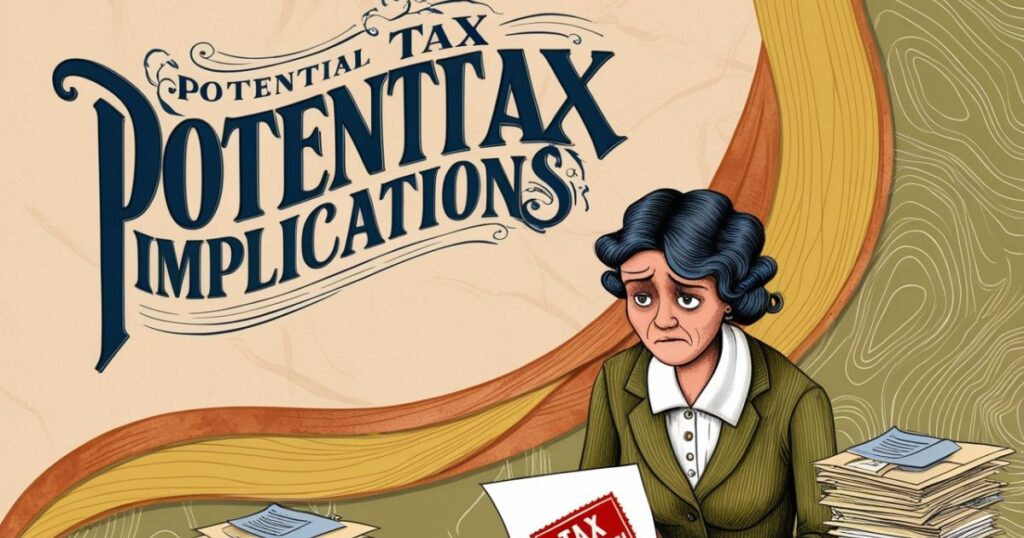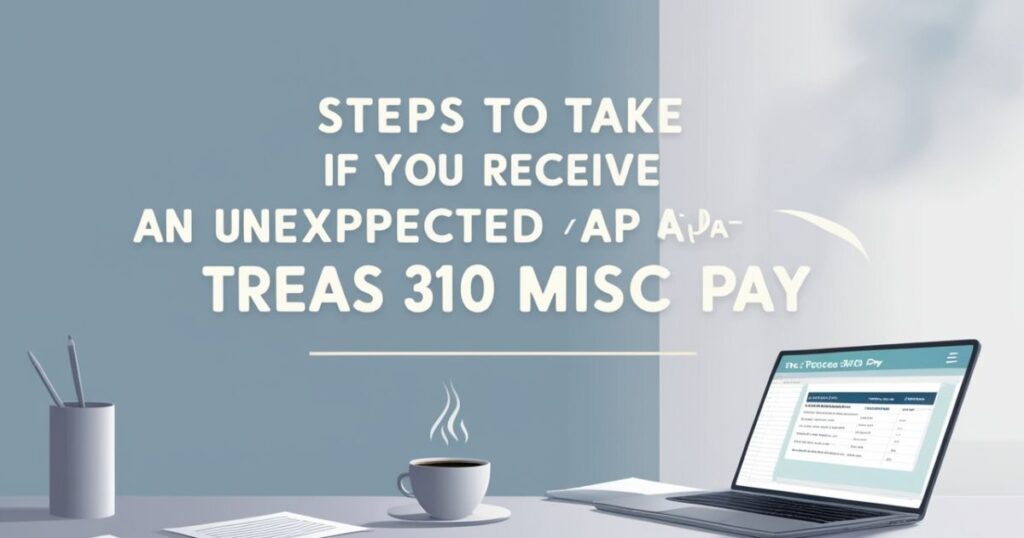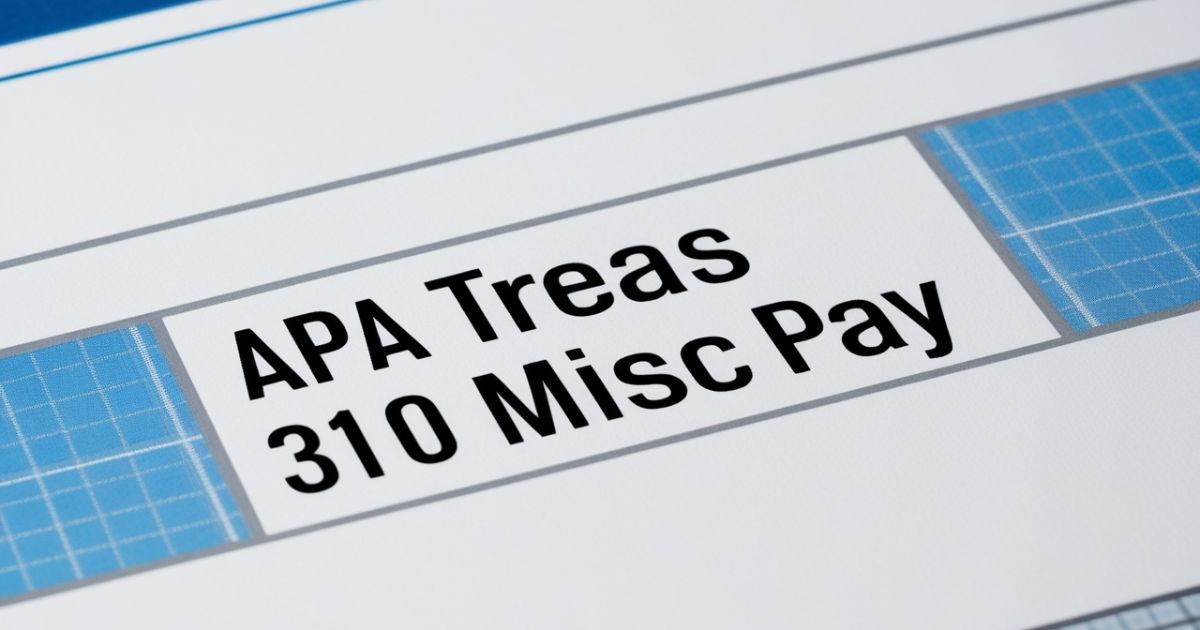When reviewing your bank statement, you may encounter a transaction labeled “APA TREAS 310 MISC PAY” that raises questions about its origin and purpose.
This designation represents an electronic deposit from the U.S. Department of the Treasury, and understanding its significance is crucial for proper financial tracking and management.
This comprehensive guide explores the meaning behind APA TREAS 310 MISC PAY transactions, their common sources, tax considerations, and documentation requirements to help you navigate these government-initiated payments effectively.
Understanding APA TREAS 310 MISC PAY Notation
The notation “APA TREAS 310 MISC PAY” on your bank statement contains specific components that identify its governmental source. “APA” refers to the Automated Payment Application system used by the federal government to process electronic disbursements.
“TREAS 310” designates the payment as originating from the U.S. Department of the Treasury, specifically through payment code 310, which is assigned to various types of government disbursements.
The “MISC PAY” portion indicates that the transaction falls under the miscellaneous payment category within the Treasury’s electronic funds transfer classification system.
These Treasury Department ACH payments are part of the modern electronic disbursement infrastructure that has largely replaced paper checks for government payments.
The Treasury has implemented this standardized notation system to facilitate efficient processing while providing recipients with a consistent way to identify federal deposits.
When you see an APA TREAS 310 deposit on your statement, you can be confident it represents a legitimate federal payment transaction code rather than an unauthorized or suspicious entry.
“The Treasury Department’s electronic payment system processes over 1.2 billion transactions annually, representing more than $3.7 trillion in federal payments.” – U.S. Treasury Fiscal Service Report
Common Reasons for This Type of Deposit
The APA TREAS 310 MISC PAY designation encompasses numerous types of federal disbursements. Understanding the most common sources can help you identify the specific nature of your deposit.
Federal Tax Refunds
One of the most frequent reasons for an APA TREAS 310 MISC PAY transaction is the receipt of federal tax refunds. The Internal Revenue Service (IRS) processes these refunds when taxpayers have overpaid their federal tax obligations through withholding or estimated tax payments. These refunds typically appear during tax filing season but may occur throughout the year in cases of:
- Standard tax return refunds after annual filing
- Amended return adjustments resulting in additional refunds
- Refundable tax credit disbursements, such as the Earned Income Tax Credit or Child Tax Credit
- Corrections to previously assessed tax liabilities
- Recovery Rebate Credits claimed on tax returns
The IRS electronic funds transfer system uses the APA TREAS 310 MISC PAY designation for these refund payments, which typically include additional reference information in the transaction details to help identify the specific tax year or form associated with the refund.
Government Benefits
Various federal benefit programs distribute payments using the APA TREAS 310 MISC PAY designation. These government benefits direct deposits include:
- Social Security retirement, disability, and survivor benefits
- Supplemental Security Income (SSI) for eligible low-income individuals
- Veterans’ benefits for service-connected compensation and pensions
- Federal employee retirement system payments
- Railroad Retirement Board benefits
- Federal civilian employee salary payments
Each of these benefit programs operates on specific payment schedules. For example, Social Security Administration deposits are typically disbursed on the 2nd, 3rd, or 4th Wednesday of each month, depending on the beneficiary’s birth date. Understanding these schedules can help you identify the specific benefit program associated with your APA TREAS 310 MISC PAY transaction.
Economic Impact Payments
During periods of economic downturn or national emergency, the federal government may issue stimulus payments through the Treasury Department to provide financial relief to eligible individuals. These economic impact payments use the APA TREAS 310 MISC PAY designation and have been distributed during significant events such as:
- Pandemic-related economic assistance programs
- Disaster relief initiatives following declared emergencies
- Economic stimulus measures during financial downturns
- Special relief programs authorized by Congress
These payments are typically one-time or limited-series disbursements rather than recurring benefits, and they may include specific identifiers in the transaction details to distinguish them from other types of Treasury payments.
Other Federal Disbursements
Additional federal payment types that may appear as APA TREAS 310 MISC PAY include:
- Grant disbursements to individuals, organizations, or educational institutions
- Settlement payments from federal agencies resulting from legal proceedings
- Vendor payments for goods or services provided to federal entities
- Federal student loan disbursements or refunds
- Treasury offset program reversals when previously withheld funds are released
These diverse payment types highlight the importance of carefully examining transaction details to determine the specific source of an APA TREAS 310 MISC PAY deposit.
Identifying the Deposit on Bank Statements
Accurately identifying the specific nature of an APA TREAS 310 MISC PAY transaction requires attention to several key elements on your bank statement and related financial records.
Transaction Detail Analysis
Your bank statement typically provides supplementary information beyond the basic APA TREAS 310 MISC PAY notation. Look for:
- Transaction IDs or reference numbers that correlate with government documentation
- Additional description text that may indicate the specific agency or program
- Notation variants such as “DOEP TREAS 310 Misc pay” (Department of Education payments) or “36 TREAS 310 MISC pay” (Veterans Affairs payments)
- Payment amounts that match expected government disbursements
Online banking platforms often provide enhanced transaction details compared to paper statements. Access your digital banking interface to view comprehensive information about the deposit, including expanded descriptions and reference codes.
Timing Correlation
The timing of an APA TREAS 310 MISC PAY deposit can provide valuable clues about its source:
| Payment Type | Typical Timing Pattern |
| Tax Refunds | 1-3 weeks after return acceptance |
| Social Security | 2nd, 3rd, or 4th Wednesday (birth date dependent) |
| SSI | 1st of the month (or previous business day) |
| Veterans Benefits | 1st of the month (or previous business day) |
| Federal Retirement | 1st business day of the month |
| Stimulus Payments | Based on legislative implementation schedule |
Understanding these timing patterns can help you correlate the deposit with expected government payments and identify its specific source.
Official Verification Methods
For definitive identification of an APA TREAS 310 MISC PAY transaction, utilize official government verification channels:
- IRS refund bank code verification through the “Where’s My Refund?” tool on IRS.gov
- Social Security payment explanation through your my.SSA.gov account
- VA.gov account access for veterans benefits direct deposit verification
- Treasury’s Bureau of the Fiscal Service payment tracking system
- Contact the relevant federal agency’s payment inquiry department
These official verification methods provide authoritative confirmation of the payment source and purpose, eliminating any uncertainty about the nature of the deposit.
Case Study: Identifying a Complex Treasury Payment
John noticed an APA TREAS 310 MISC PAY transaction of $1,463 on his March bank statement. To identify the payment source, he:
- Checked his online banking for additional details, finding “TAX REF” in the expanded description
- Verified the amount matched his expected federal tax refund
- Confirmed through the IRS “Where’s My Refund?” tool that his refund was processed on the same date
- Located his IRS refund confirmation email with matching payment amount
This systematic approach allowed John to conclusively identify the payment as his federal tax refund rather than another type of Treasury disbursement.
Read This Post: What Is the Primary Feature of a Viatical Settlement?
Potential Tax Implications

Understanding the tax implications of an APA TREAS 310 MISC PAY deposit is essential for accurate tax planning and compliance with Internal Revenue Code (IRC) requirements. The tax treatment varies significantly depending on the payment type.
Non-Taxable Treasury Payments
Many APA TREAS 310 MISC PAY transactions represent funds that are not subject to federal income taxation:
- Federal tax refunds represent a return of your own money and are generally not taxable
- Most stimulus payments and economic impact payments are specifically designated as non-taxable by legislation
- Certain veterans’ benefits are exempt from taxation under specific IRC provisions
- Disaster relief payments designated for basic living expenses or property replacement
- Educational assistance payments used for qualified educational expenses
These non-taxable payments generally do not need to be reported on your federal tax return, though you should maintain documentation of these deposits for your financial records.
Taxable Government Disbursements
Other APA TREAS 310 MISC PAY transactions may represent income that is subject to federal taxation:
- Unemployment compensation is typically taxable and reported on Form 1099-G
- Social Security benefits may be partially taxable depending on your combined income
- Federal retirement payments are generally taxable as pension income
- Railroad Retirement benefits follow complex taxation rules based on benefit tier and recipient income
- Interest payments on delayed refunds or settlements
For these taxable payments, you’ll typically receive corresponding tax documents, such as a Form 1099-G for unemployment benefits or a Form SSA-1099 for Social Security benefits, which must be included in your tax preparation process.
Impact on Adjusted Gross Income
The inclusion of taxable APA TREAS 310 MISC PAY deposits in your income can affect your Adjusted Gross Income (AGI), which may influence:
- Eligibility for valuable tax credits such as the Earned Income Credit or Child Tax Credit
- Phase-out thresholds for certain tax deductions and credits
- Medicare premium determinations for higher-income beneficiaries
- Financial aid eligibility for educational programs
- Qualification for means-tested government benefits
These potential cascading effects highlight the importance of proper identification and classification of APA TREAS 310 MISC PAY transactions for comprehensive tax planning.
Legislative Considerations
Recent legislative changes, including the Tax Cuts and Jobs Act of 2017, have modified the taxation of certain government payments. These changes may affect how specific APA TREAS 310 MISC PAY deposits are treated for tax purposes. Consulting with a qualified tax professional can help ensure you apply the current tax rules correctly to your specific situation, particularly for complex scenarios involving multiple types of government payments.
Retaining Required Documentation
Maintaining proper documentation for APA TREAS 310 MISC PAY transactions is essential for financial tracking, compliance with regulatory requirements, and potential audit defense.
Essential Documentation Types
For comprehensive recordkeeping of APA TREAS 310 MISC PAY transactions, retain:
- Bank statement copies showing the complete transaction details
- Government notices explaining payment eligibility, calculation, and purpose
- Tax forms associated with the payment (e.g., Form 1099-G, Form SSA-1099)
- Correspondence from federal agencies regarding the payment
- Payment confirmation emails or notifications
- Screenshots of online account verifications of payment issuance
These documents serve as primary evidence of the payment’s source, purpose, and eligibility during tax preparation and potential audits.
Documentation Organization Systems
Implementing an effective organization system ensures efficient document retrieval when needed:
Digital Documentation Management:
- Scan paper documents to create digital copies
- Use descriptive file naming conventions including date, source, and purpose
- Organize files in logical folder structures by year and payment type
- Implement secure cloud-based platforms with encryption for sensitive financial documents
- Create regular backups of digital financial records
Physical Documentation System:
- Use labeled folders organized by year and payment type
- Store documents in a secure, waterproof, and fireproof container
- Create a master index of stored documents for quick reference
- Include cross-reference notes for related documents stored elsewhere
Hybrid Approach:
- Maintain original physical documents for legal requirements
- Create digital backups for convenience and disaster recovery
- Develop a consistent system for determining which documents require physical retention
Retention Timeframes
Adhere to recommended retention periods for APA TREAS 310 MISC PAY documentation:
- Tax-related documents: Minimum of 3 years from filing date (IRS statute of limitations)
- Property-related payments: For the duration of property ownership plus 3 years
- Income-based benefit documentation: 7 years recommended due to extended audit periods
- Identity verification documents: 7 years due to potential identity theft concerns
- Settlement payments: Permanently for legal reference
These retention periods ensure you maintain adequate documentation throughout the applicable regulatory windows while facilitating proper financial tracking and management.
“Proper documentation is your first line of defense in case of financial disputes or tax inquiries. For government payments, maintaining comprehensive records is particularly important due to their potential impact on multiple aspects of your financial life.” – Financial Planning Association
Steps to Take if You Receive an Unexpected APA TREAS 310 MISC PAY

Receiving an unexpected APA TREAS 310 MISC PAY deposit requires careful verification to ensure it represents a legitimate payment to which you’re entitled rather than an error or potential fraud indicator.
Verification Procedure
Follow these steps to verify an unexpected Treasury Department ACH payment:
- Document the transaction details from your bank statement, including exact amount, date, and any reference information
- Check recent tax filings for potential refunds or credits you may have overlooked
- Review government benefit applications or program enrollments that might generate payments
- Consult official government payment trackers specific to the suspected payment type
- Contact the relevant federal agency’s payment inquiry department if the source remains unclear
These verification steps help determine whether the payment is legitimate and intended for you specifically.
Contact Protocols
If verification steps don’t resolve the payment’s source, contact the appropriate government entity:
- IRS: 800-829-1040 for tax-related inquiries
- Social Security Administration: 800-772-1213 for SSA payments
- Veterans Affairs: 800-827-1000 for VA benefit questions
- Treasury Department: 800-304-3107 for general Treasury payment inquiries
- Your financial institution’s fraud department if you suspect error or fraud
When contacting these agencies, have your identifying information, transaction details, and specific questions prepared to facilitate efficient resolution.
Handling Potential Errors
If you determine a payment was issued in error:
- Do not spend the funds if you believe they were sent in error
- Document all communications with government agencies regarding the erroneous payment
- Follow official procedures for returning incorrectly issued payments
- Request written confirmation of payment resolution for your records
- Monitor your account for any correction transactions or adjustments
Promptly addressing payment errors helps avoid potential complications, including future reclamation attempts that could result in unexpected account debits.
Conclusion
APA TREAS 310 MISC PAY transactions represent an important category of government disbursements that may appear on your bank statement throughout the year. By understanding the meaning behind this designation, identifying common payment sources, managing tax implications, and maintaining proper documentation, you can effectively navigate these Treasury payments.
Remember that most APA TREAS 310 MISC PAY transactions represent legitimate federal disbursements based on your tax filings, benefit eligibility, or economic relief programs. Proper identification of these payments ensures accurate financial tracking and appropriate tax planning while maintaining necessary records for potential future reference.
If you encounter difficulties identifying a specific APA TREAS 310 MISC PAY transaction, utilize the verification resources and contact protocols outlined in this guide to determine the payment’s source and purpose. This proactive approach to managing government payments contributes to comprehensive financial management and regulatory compliance.
FAQ’s
Why did I get a deposit from APA Treas 310?
An APA TREAS 310 MISC PAY deposit indicates a federal payment from the U.S. Treasury Department, which could be a tax refund, Social Security benefit, veterans’ benefit, unemployment compensation, or stimulus payment based on your eligibility for government programs.
What is a treas 310 misc pay deposit for?
A TREAS 310 MISC PAY deposit represents a miscellaneous federal payment processed through the Treasury’s Automated Clearing House system, covering various disbursements including tax refunds, government benefits, and economic impact payments based on your specific circumstances and program eligibility.
Why did I get an SSA 310 deposit?
An SSA 310 deposit indicates a Social Security Administration payment, which could be regular retirement benefits, disability payments, Supplemental Security Income (SSI), or survivor benefits following the administration’s established payment schedule based on your birth date and benefit type.
What does APA Treasury mean?
APA Treasury refers to the Automated Payment Application system used by the U.S. Department of the Treasury for processing millions of electronic disbursements daily, replacing traditional paper checks for greater efficiency, security, and cost-effectiveness in delivering government payments.
How do I report APA TREAS 310 MISC PAY on my taxes?
Reporting requirements for APA TREAS 310 MISC PAY transactions depend on the specific payment type: tax refunds generally aren’t reportable income, Social Security benefits may be partially taxable, unemployment compensation must be reported via Form 1099-G, while economic stimulus payments typically don’t require reporting.
Can APA TREAS 310 MISC PAY deposits be garnished or reversed?
Yes, certain APA TREAS 310 MISC PAY deposits can be garnished through the Treasury Offset Program to satisfy delinquent debts (like unpaid taxes or child support) or reversed if determined to be issued in error, though some payments like Social Security have specific garnishment protections with limited exceptions.
How can I verify the legitimacy of an APA TREAS 310 MISC PAY deposit?
Verify an APA TREAS 310 MISC PAY deposit through official government channels: use the IRS “Where’s My Refund?” tool for tax refunds, my.SSA.gov for Social Security payments, VA.gov for veterans’ benefits, your state’s unemployment portal for unemployment compensation, or contact the Bureau of the Fiscal Service at 800-304-3107 for general Treasury payment inquiries.

Hello, I’m Nadeem Sattar, a contributing editor at Opals Magazine. I navigate the intersection of Finance and Technology, delivering insightful analysis and forward-thinking perspectives. Join me on OpalsMAgazine.com for expert coverage of financial innovations, investment strategies, and emerging technologies reshaping our economic landscape.








